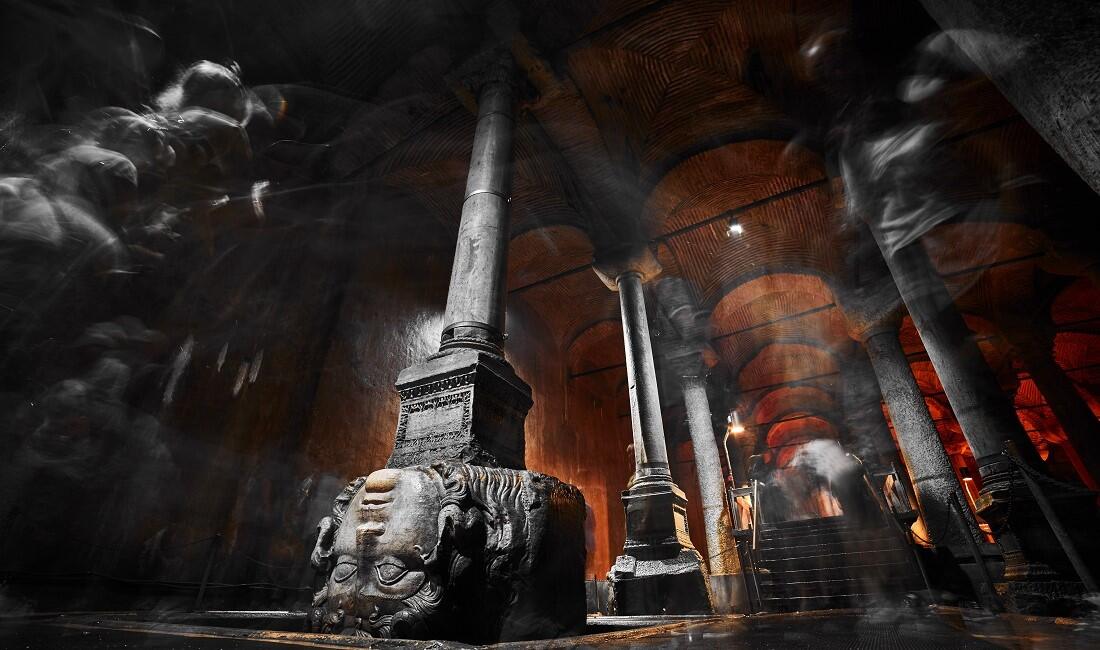
The Basilica Cistern, Yerebatan Sarnici in Turkish, is an ancient underground water storage system in Istanbul, Turkey. It is beneath the city’s historic district of Sultanahmet, near the Hagia Sophia and the Blue Mosque. The cistern, which dates back to the 6th century, was built during the reign of the Byzantine Emperor Justinian I. It is the largest and most impressive of the many underground cisterns constructed in Istanbul during the Byzantine era to supply the city with a steady water supply.
The cistern is roughly 140 meters by 70 meters in size and rectangular. It has a capacity of over 80,000 cubic meters of water, which was brought into the city from the nearby Belgrade Forest via aqueducts. It is not only a remarkable engineering feat, but it is also an important historic site that provides insight into Istanbul’s rich past. The cistern was used for over a thousand years, and during this time, it played a vital role in the city’s survival.
Today, Istanbul is fortunate to have the Basilica Cistern as one of its most famous places. Its beautiful architecture and rich history attract people from all over the world.
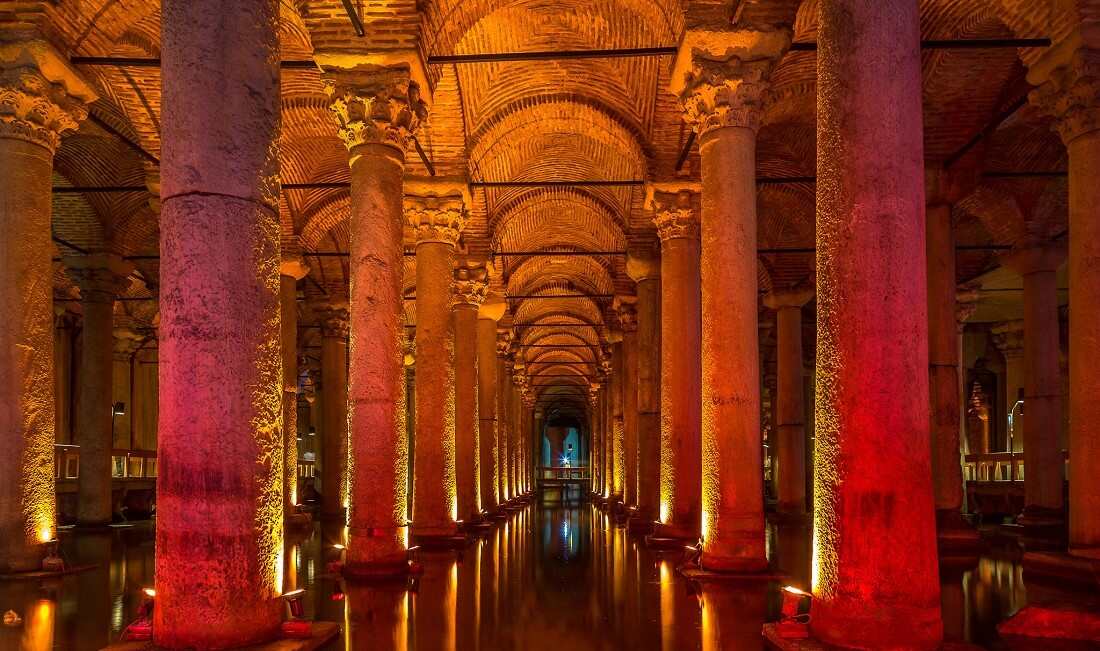
The Basilica Cistern has significant historical importance in Istanbul’s history. During the Byzantine era, Istanbul (known as Constantinople at the time) was a bustling metropolis and an important political, cultural, and economic center of the Byzantine Empire. A reliable water supply was essential to the city’s survival, and the Basilica Cistern, among other cisterns, provided it. The cistern continued to play a vital role in the city’s water supply even after the Ottoman Empire conquered Constantinople in 1453 and renamed it Istanbul.
Justinian I, the Byzantine Emperor, built the Basilica Cistern in the sixth century CE. It was created to provide a reliable water supply for the Great Palace of Constantinople, which was nearby. The cistern was built on the site of a previous cistern that was destroyed during the Nika riots of 532 CE.
A team of skilled workers and engineers constructed the cistern. They used over 336 marble columns, some repurposed from earlier structures, to support the vaulted roof. The cistern’s walls are brick and coated with waterproof mortar. Arches support the cistern’s roof, bringing water into the cistern via aqueducts.
Throughout its history, the Basilica Cistern was a water source for the city and a site for various events. During the reign of Emperor Justinian I, a group of rebels known as the Nika Rioters found refuge in the cistern. This event marked a notable moment in history. Justinian’s army cornered the rebels in the cistern and massacred them. In the Ottoman period, the cistern was used for various purposes, including storing tobacco and charcoal. During World War II, the cistern was used as a bomb shelter, and later, the Municipality of Istanbul restored it and made it available to the public as a tourist attraction.
Today, the cistern is used for various cultural events, including music concerts and art exhibitions, adding to its significance as a historical and cultural landmark in Istanbul.
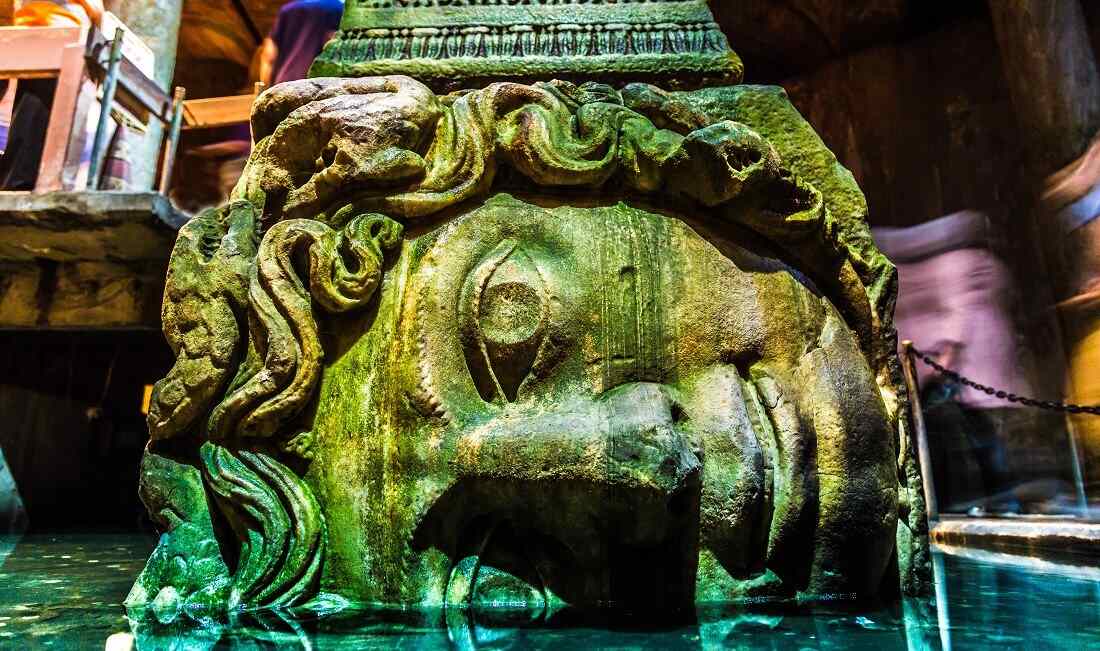
The cistern has two Medusa heads, which have been repurposed from earlier structures. They are at the base of two columns of the cistern. The heads have been placed upside down to negate their power, as they were associated with evil spirits in Greek mythology.
The Basilica Cistern has several unique features that make it stand out among other cisterns in Istanbul. First, the beautiful forest of columns that magnificently supports the cistern’s ceiling is impressive. Most of the columns came from older buildings, and many of them have complex carvings and patterns.
The Basilica Cistern’s columns are adorned with various artistic and architectural details that reflect the Byzantine era’s design style. The columns feature Ionic and Corinthian capitals decorated with intricate carvings and designs. The cistern’s walls are made of brick and covered with waterproof mortar. Arches and vaults support the ceiling of the cistern, which is made of brick and covered with waterproof mortar.
The cistern’s columns and ceiling are lit by dim lighting, which creates a serene and atmospheric environment. The cistern’s water is also illuminated, which creates a magical effect that adds to the cistern’s mystique.
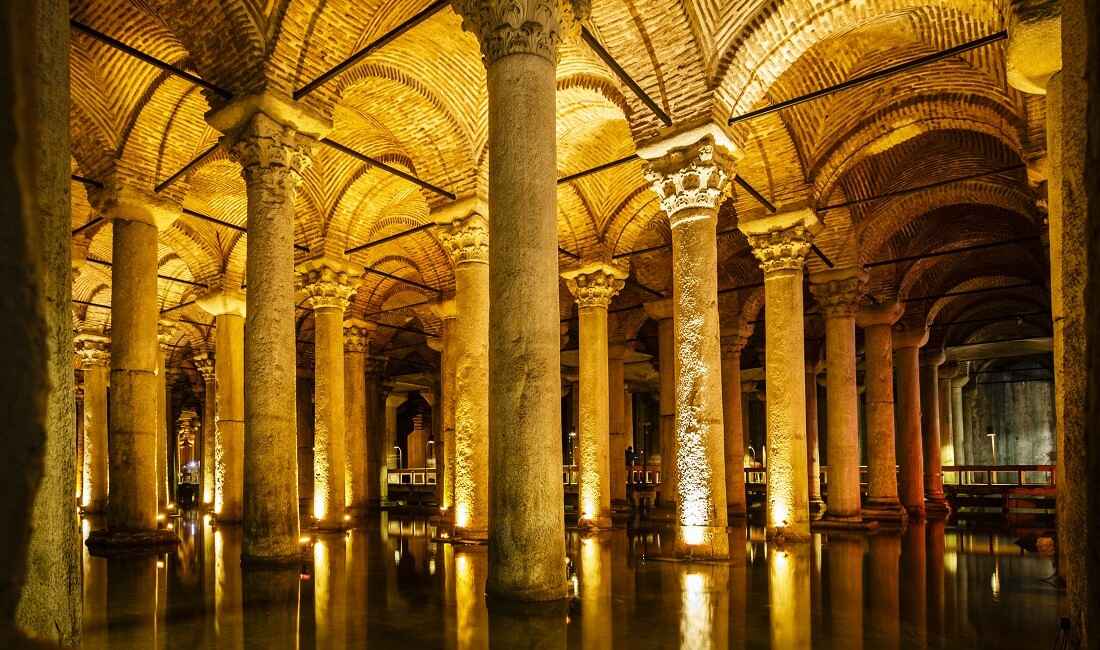
The Basilica Cistern is a historical landmark that requires ongoing efforts to preserve and conserve its features. The Istanbul Metropolitan Municipality manages the cistern and has implemented various measures to protect and maintain the cistern’s structural integrity and historical significance.
In the 1980s, a drainage system had to be installed for the tank to stay in good shape. Before this, the cistern was susceptible to flooding, which could damage the marble columns and other features. The drainage system, which is still in use today, helps to control the water levels within the cistern and prevent flooding.
Over the years, several restoration projects have occurred at the Basilica Cistern to repair and maintain its features. One of the most significant restoration projects appeared in the 1990s, during which the cistern’s columns and vaults were repaired and cleaned, and the Medusa heads were restored.
The Istanbul Metropolitan Municipality has recently undertaken various restoration projects to preserve the cistern’s features and enhance the visitor experience. For example, in 2020, the municipality updated the cistern’s lighting system to provide visitors with a more immersive and atmospheric experience.
The Istanbul Metropolitan Municipality has stated that it will continue to prioritize the preservation and restoration of the Basilica Cistern. Plans include installing additional lighting and ventilation systems to give visitors a better time and keep the cistern’s features safe.
In addition, the municipality is exploring new technologies and methods for preserving the cistern’s unique features, such as 3D scanning and printing. These technologies can make exact copies of the cistern’s parts. These copies can be used for education, study, and to help restore the cistern.
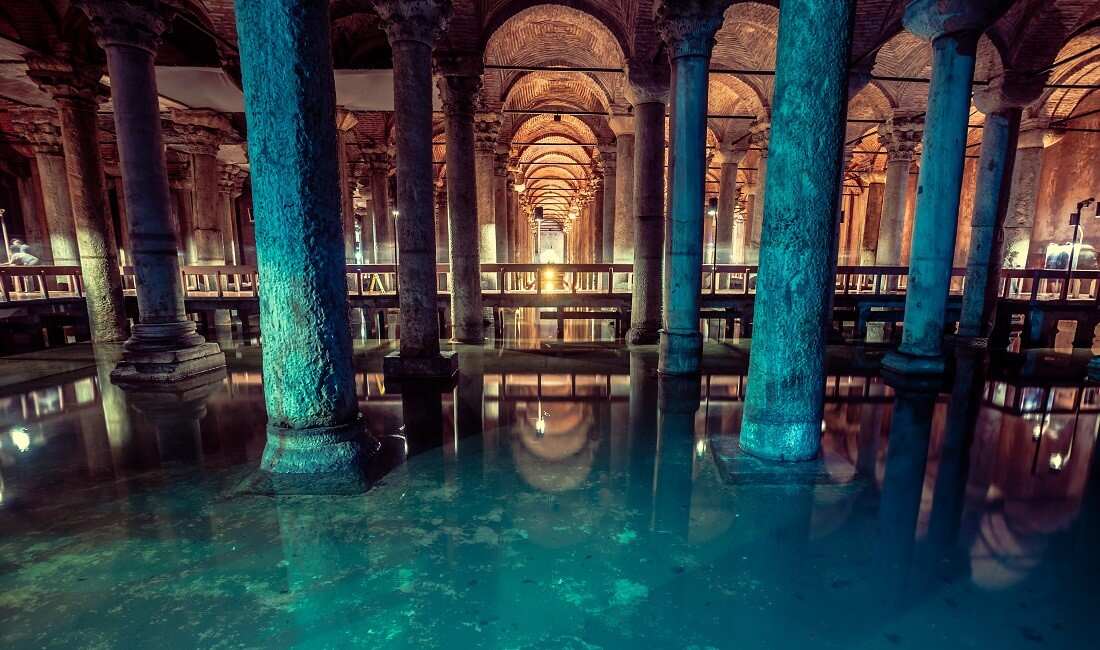
The Basilica Cistern holds great cultural significance in Turkey and is a popular destination for locals and tourists. It is an excellent example of Byzantine engineering and architecture in Istanbul, symbolizing its long past and cultural heritage.
When Justinian I was emperor of the Byzantine Empire in the sixth century, the Basilica Cistern was built. At the time, Constantinople, which is now Istanbul, was growing and changing quickly.
The tank was built so that the growing number of people in the city would always have access to water. It was built where an old church used to be. The columns of the cistern came from other buildings, like churches and castles. This makes the tank look different and unique.
Over the years, the cistern has had many different parts in the city’s history. It was used to store water during times of war, and it was also a place to throw away trash and other things. In the 1600s, the cistern was lost. By chance, a Dutch traveler came across it and found it again.
For Christians and Muslims, the spiritual value of the Basilica Cistern is significant. The cistern was likely constructed on the site of a pagan temple, which was then occupied by an antique basilica.
Some believe that the cistern’s two Medusa heads, located at the base of two columns, were placed there to ward off evil spirits. Others believe the heads were placed there as a reminder of the city’s pagan past.
For Muslims, the cistern is believed to be where the Prophet Muhammad’s horse, Buraq, ascended into heaven during his Night Journey. This event is commemorated with a plaque that is near the entrance to the cistern.
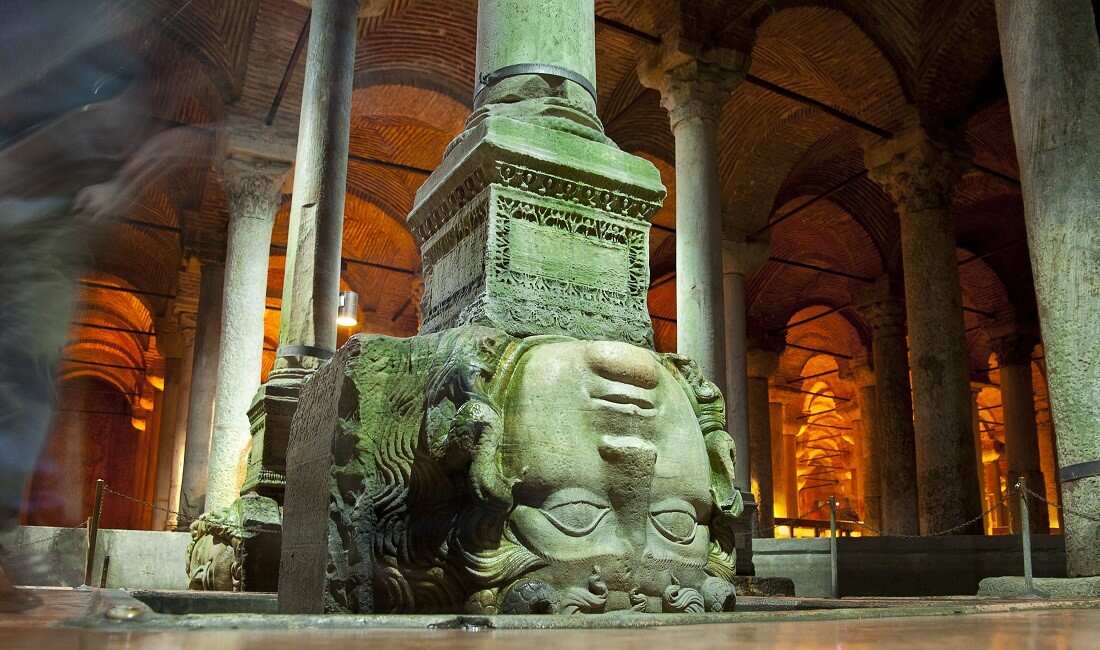
The Basilica Cistern is located in the heart of Istanbul’s historic Sultanahmet district, home to many other important cultural and historical attractions. In addition, the surrounding area is a UNESCO World Heritage Site. Some of the nearby attractions include:
Hagia Sophia: It is a magnificent Byzantine church from the 6th century that was turned into a mosque by the Ottomans and then turned into a museum.
Topkapi Palace: The Ottoman sultans lived in this sprawling collection of buildings for almost 400 years.
Blue Mosque: A stunning 17th-century mosque with six minarets adorned with intricate blue tiles, hence its nickname.
Grand Bazaar: One of the biggest and longest-covered markets in history. It has over 4,000 shops where you can buy everything from spices to souvenirs.
Visiting the Basilica Cistern is an absolute must for those interested in history, architecture, and engineering. It is a unique and awe-inspiring site with impressive artistic and architectural details that impress visitors. Also, the area around the cistern is full of other historical and cultural sites, making it a great place to spend a day visiting.
In conclusion, the Basilica Cistern is a fascinating destination that offers a glimpse into Istanbul’s rich history and culture. It is an important historical landmark well-preserved, and its future seems secure. Therefore, travelers are encouraged to visit the cistern to experience its unique beauty and immerse themselves in its rich history.
